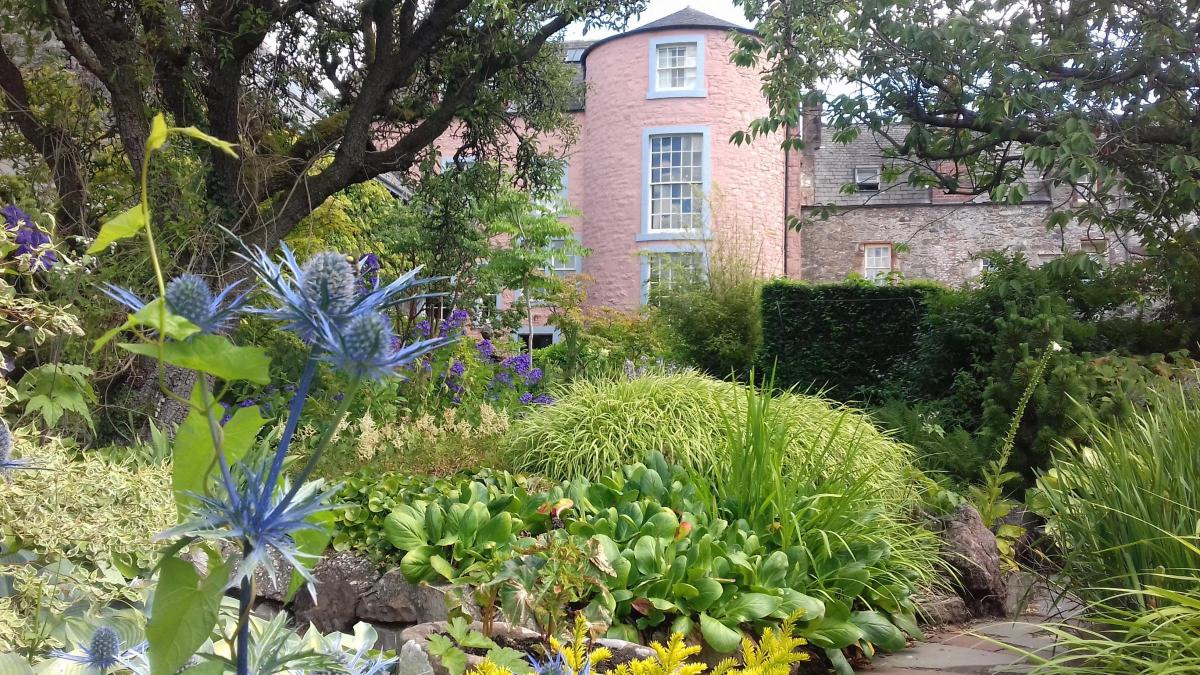Broughton House
12 High Street
Kirkcudbright
Dumfries and Galloway
DG6 4JX
The artists’ colony that emerged in the Galloway town of Kirkcudbright in the early 20th century attracted some of the finest painters of the day but its leading light was local painter, EA Hornel, one of the “Glasgow Boys”, a group of artists whose depictions of the natural world, often painted in the open air, took art in a fresh direction.
Hornel lived in a large pink-washed building in the heart of the town and here he built a studio and a gallery as well as a library which he filled with an extensive collection of the works of Robert Burns.
Today Hornel’s home is a museum, filled with his canvases and with his many antiquarian treasures, while behind the house lies the garden which he created along with his sister Tizzy, and which many also consider a work of art in its own right.
The garden is a traditional Scottish rigg that stretches down to the edge of the River Dee. At some point Hornel purchased the garden next door, doubling the amount of space and allowing him to pursue his passion for plants on a wider scale.
What shaped the garden was Hornel’s love of the Orient and during two long journeys in Japan, one of them sponsored by Sir William Burrell, the artist returned not only with new subjects for his paintings but also with new ideas of how to design his outdoor space.
Close to the house he created a sunken area, which he filled with moss and ferns and he set stepping stones into a lily pond, making it the main route to a decorative summer house. This proved to be a treacherous obstacle for at least one housemaid, who fell into the water with a laden tea tray.
Cherry trees were an essential feature of the garden and so too were the many stone artefacts which Hornel gathered from the countryside around the town. These included a pilgrim waymarker from the Galloway hills, a stone cist and seven separate sundials, which he had placed around the garden.
Snowdrops were also an obsession with Hornel and as well as growing them, he included them in many of his paintings.
Throughout his life, Hornel continued to add to his collections of plants and artworks and the garden was maintained by Tizzy after the artist’s death in 1933.
Decorative and Productive
Hornel was an artist of the arts and crafts tradition and his flower borders, edged with low box hedging, spilled over with voluminous planting in vivid colours. These borders are still packed with flowers today and Hornel’s vegetable plot at the far end of the garden remains as productive as it was when the artist was alive. From it there are picturesque views of sailing boats at anchor in Kirkcudbright harbour.
Fruitful and Flavoursome
The apple tree that stands near the centre of the garden is Malus domestica ‘Annie Elizabeth’. It was planted by Hornel and still produces fruit today. It is a cooking apple that is sweet enough to be eaten as a dessert apple, but which retains its shape when stewed. In the autumn, visitors to the garden can take away ripe apples to make into pies and crumbles.
Details
Broughton House is open daily, 10am-4pm. Tickets: £8/£7/£1 Young Scot). Kirkcudbright is two hours south of Glasgow on the M74/75.
www.nts.org
Diary Date
Scone Palace Garden Fair returns on Friday, June 2 and Saturday, June 3. Top nurseries in attendance will include Binny Plants, Elmlea Plants, The Plant Market and Kevock Garden.
George Anderson and Carole Baxter from The Beechgrove Garden will be at the show over both days and as well as talks and demonstrations, there will be a garden design competition.
Entrance to the Garden Fair also gives access to the entire gardens and grounds of The Palace, with garden walks, a kitchen garden, Victorian pinetum and star-shaped maze. Tickets priced £13.50 are available from scone-palace.co.uk






Why are you making commenting on The Herald only available to subscribers?
It should have been a safe space for informed debate, somewhere for readers to discuss issues around the biggest stories of the day, but all too often the below the line comments on most websites have become bogged down by off-topic discussions and abuse.
heraldscotland.com is tackling this problem by allowing only subscribers to comment.
We are doing this to improve the experience for our loyal readers and we believe it will reduce the ability of trolls and troublemakers, who occasionally find their way onto our site, to abuse our journalists and readers. We also hope it will help the comments section fulfil its promise as a part of Scotland's conversation with itself.
We are lucky at The Herald. We are read by an informed, educated readership who can add their knowledge and insights to our stories.
That is invaluable.
We are making the subscriber-only change to support our valued readers, who tell us they don't want the site cluttered up with irrelevant comments, untruths and abuse.
In the past, the journalist’s job was to collect and distribute information to the audience. Technology means that readers can shape a discussion. We look forward to hearing from you on heraldscotland.com
Comments & Moderation
Readers’ comments: You are personally liable for the content of any comments you upload to this website, so please act responsibly. We do not pre-moderate or monitor readers’ comments appearing on our websites, but we do post-moderate in response to complaints we receive or otherwise when a potential problem comes to our attention. You can make a complaint by using the ‘report this post’ link . We may then apply our discretion under the user terms to amend or delete comments.
Post moderation is undertaken full-time 9am-6pm on weekdays, and on a part-time basis outwith those hours.
Read the rules here